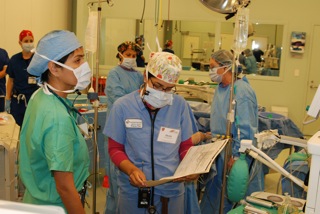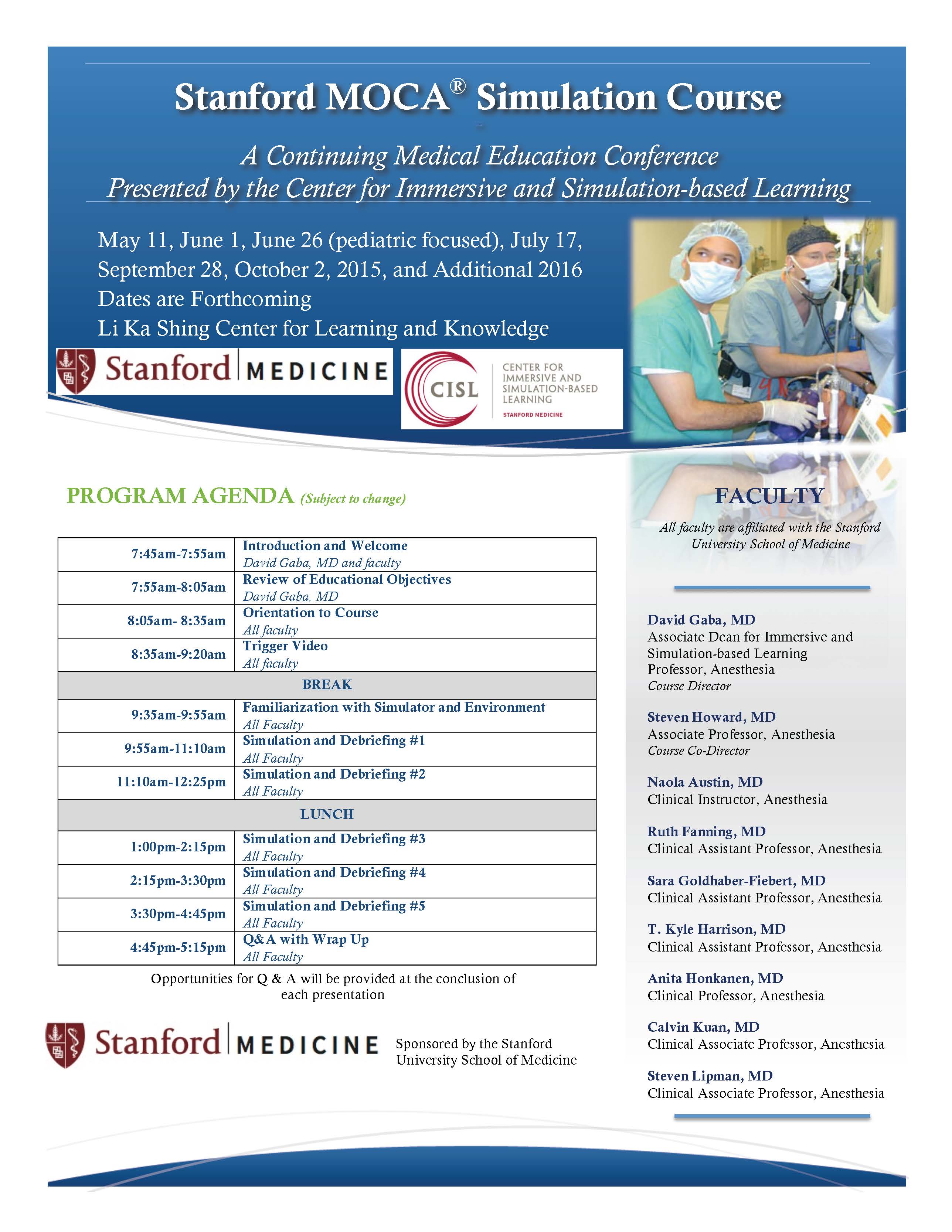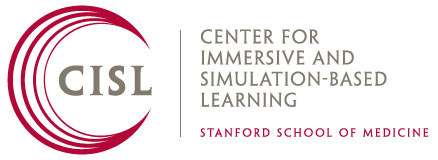Stanford Maintenance of Certification in Anesthesiology® (MOCA) Simulation Course
Fulfill one requirement of the ABA's MOCA® Part IV at Stanford!

The American Board of Anesthesiology (ABA) now requires anesthesiologists to participate in one simulation-based training course every ten years in order to maintain certification. The Stanford MOCA Simulation Course fulfills one requirement of Part IV of the ABA in a state of the art simulation center located in the heart of the Stanford Medical School. Stanford University boasts a world renowned faculty who have been pioneers in the field of simulation as a methodology. They have been thought leaders and responsible for much of the work done in the field of anesthesia simulation. Stanford University is an American Society of Anesthesiologists (ASA) Simulation Education Network (SEN) endorsed site. This exciting course allows each participant the opportunity to:
participate in at least one scenario in the hot seat"
participate in at least one scenario as a secondary responder
reflect on personal and team performance
All activity within this course, including your performance, is confidential. Take advantage of this opportunity to meet your ABA requirements with seasoned simulation faculty members.
Upcoming Stanford MOCA Simulation Course Dates
Friday, January 29, 2016 (FULL)
Save the Date
Monday, March 14, 2016 (3 seats available)
Monday, May 16, 2016 (FULL)
Friday, June 10, 2016 (4 seats available)
Click here register/save the date
Note: If you would like to be placed on the wait list for any of the courses above, please fill out the registration form, and you will be contacted if openings arise due to cancellation. Please also check back in the next month or two, as more dates will be posted as they are scheduled.
For more information, fill out the brief form at http://tinyurl.com/MOCAstanford and we will contact you with details
Stanford MOCA Simulation Course Facts
Maximum Course Size: 5 participants
Instructor to Participant Ratio: approximately 3:5
Course Duration: 7:45 a.m. - 5:15 p.m. (breakfast and lunch provided)
Course Location: Goodman Immersive Learning Center, Li Ka Shing Center for Learning and Knowledge (LKSC), Stanford University School of Medicine
CME Credit Available: Yes! See brochure for details.
Registration Fee: $2000 (payable by check to Stanford University)
For more information about MOCA courses from the ABA please take a moment to view this information video: http://www.theaba.org/simvid.htm
Weinger MB, Burden AR, Steadman, RH, Gaba DM. This Is Not A Test! Misconceptions Surrounding the Maintenance of Certification in Anesthesiology Simulation Course. Anesthesiology, 2014. 121:655-659.
Latest Clarification of ABA MOCA Simulation Requirement under MOCA 2.0: June 16, 2015:
On April 23, 2015, the American Board of Anesthesiology (ABA) announced changes to the Maintenance of Certification in Anesthesiology Program (MOCA®), known as MOCA 2.0. In the ABA MOCA 2.0 program, highfidelity simulation will be strongly encouraged as the ABA considers it a valuable educational tool, but it will no longer be required as of January 1, 2016. More than 90% of the 5,000 diplomates who have participated in a MOCA simulation course reported the experience to be relevant and result in practice improvements.
The ABA is developing a point system for Part 4 activities that will include the addition of a variety of options to meet the Part 4: Improvement in Medical Practice requirement while providing flexibility that allows diplomates opportunities to complete activities relevant to their practice. These activities will be weighted based on the time and effort associated with completing them and simulation will remain a heavily weighted, Part 4 option. In addition, in the ABA MOCA 2.0 program, diplomates will have the option to participate in a MOCA simulation course for Part 4 credit within both five-year periods of the 10-year MOCA cycle. The ABA will provide additional information later this summer on Part 4 activities and their weighting.
In the interim, the current ABA MOCA program remains in effect until December 31, 2015 and diplomates may need to fulfill the following requirements based on when their certificates expire:
For diplomates whose five- or 10-year cycle ends December 31, 2015: ABA diplomates are still required to complete one of these options for Part 4 – an ASA PPAI module, a MOCA simulation course at an ASA-endorsed center, a self-directed case evaluation, a quality improvement project through the Multi-Specialty Portfolio Program or a Part 4 activity through another ABMS Member Board. If you haven’t yet completed one, you must do so before the end of this year.
For diplomates whose five- or 10-year cycle ends in 2016 or thereafter: A MOCA simulation course at an ASA-endorsed center will continue to count toward the Part 4 requirement in the ABA MOCA 2.0 program and will be heavily weighted. It will continue to count for five years of Part 4 credit, as it does now.
For additional information please follow this link: http://education.asahq.org/sim/moca2.0provided by Randy Steadman, MD, MS who is the Editor-in-Chief, ASA Editorial Board for Simulation-Based Training.


